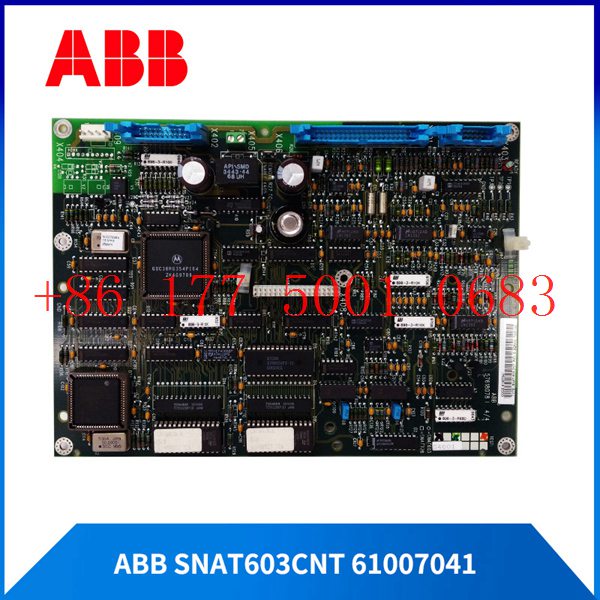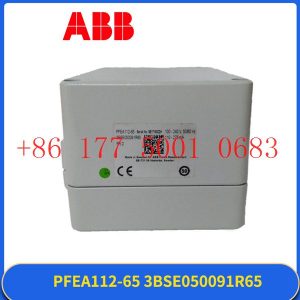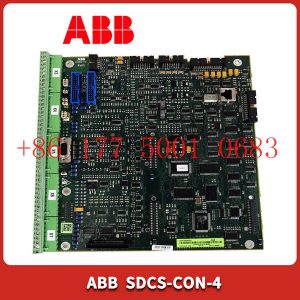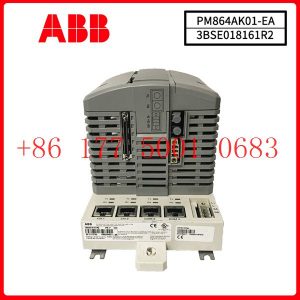Description
hardware flow control. It is an ideal choice in the field of industrial automation.
Nine Questions and Answers on Common Faults in ABB Industrial Robot Applications
Question 1: Under what circumstances do I need to back up my robot?
Answer: 1. After the new machine is powered on for the first time.
2. Before making any modifications.
3. After completing the modification.
4. If the robot is important, conduct it regularly once a week.
5. It is best to make a backup on a USB flash drive.
6. Delete old backups regularly to free up hard drive space.
Second question: What does the alarm message 10106 maintenance time reminder mean when the robot appears?
Answer: This is the intelligent periodic maintenance reminder of ABB robots.
Question 3: What should I do if the robot enters a system failure state when it is powered on?
Answer: 1. Restart the robot.
2. If it doesn”t work, check whether there is a more detailed alarm prompt on the teaching pendant and handle it.
3. Restart.
4. If it still cannot be lifted, try B startup.
5. If it still doesn’t work, try P startup.
6. If it still doesn’t work, try I startup (this will return the robot to factory settings, be careful).
Question 4: Can robot backup be shared by multiple robots?
Answer: No, for example, the backup of robot A can only be used for robot A, not robots B or C, because this will cause system failure.
Five questions: What files can be shared in the robot backup?
Answer: If the two robots are of the same model and configuration. You can share RAPID programs and EIO files, but they must be verified before they can be used normally.
Question 6: What is the mechanical origin of the robot? Where is the mechanical origin?
Answer: The six servo motors of the robot have a unique fixed mechanical origin. Incorrectly setting the mechanical origin of the robot will cause problems such
as limited movement or malfunction of the robot, the inability to walk in a straight line, etc., and serious damage to the robot.
Question 7: How to cancel the robot 50204 motion monitoring alarm?
Answer: 1. Modify the robot action monitoring parameters (control panel – action monitoring menu) to match the actual situation.
2. Use the AccSet command to reduce the robot”s acceleration.
3. Reduce the v_rot option in the speed data.
Eight questions: What should I do if the robot alarms “50296, SMB memory data difference” when it is powered on for the first time?
Answer: 1. Select calibration in the ABB main menu.
2. Click ROB_1 to enter the calibration screen and select SMB memory.
3. Select “Advanced” and click “Clear Control Cabinet Memory” after entering.
4. Click “Close” when finished, then click “Update”.
5. Select “The control cabinet or robot has been exchanged, and the control cabinet is updated using SMB memory data.”
Question 9: How to customize the speed of robot trajectory in the RAPID program?
Answer: 1. Select program data in the main menu of the teaching pendant.
2. After finding the data type Speeddata, click New.
3. Click on the initial value. The meanings of the four variables of Speeddata are: v_tcp represents the linear operating speed of the robot, v_rot
represents the rotational operating speed of the robot, v_leax represents the linear operating speed of the additional axis, v_reax represents the rotational
operating speed of the additional axis, if there is no additional axis, then No need to modify the two.
4. The customized data can be called in the RAPID program.
Excitation system ABB module 3HAC3319-1
Excitation system ABB module 3HAC3243-19
Excitation system ABB module 3HAC3180-1
Excitation system ABB module 3HAC2810-1
Excitation system ABB module 3HAC2776-1
Excitation system ABB module 3HAC2566-2
Excitation system ABB module 3HAC2493-1
Excitation system ABB module 3HAC2206-1
Excitation system ABB module 3HAC2148-1
Excitation system ABB module 3HAC2132-1
Excitation system ABB module 3HAC1852-2
Excitation system ABB module 3HAC1852-1
Excitation system ABB module 3HAC18100-1
Excitation system ABB module 3HAC17992-1
Excitation system ABB module 3HAC17971-1
Excitation system ABB module 3HAC1790-1
Excitation system ABB module 3HAC17757-7
Excitation system ABB module 3HAC17757-6
Excitation system ABB module 3HAC17757-5
Excitation system ABB module 3HAC17757-4
Excitation system ABB module 3HAC17757-3
Excitation system ABB module 3HAC17757-2
Excitation system ABB module 3HAC17756-7
Excitation system ABB module 3HAC17756-6
Excitation system ABB module 3HAC17756-5
Excitation system ABB module 3HAC17756-4
Excitation system ABB module 3HAC17756-3
Excitation system ABB module 3HAC17756-2
Excitation system ABB module 3HAC17755-1
Excitation system ABB module 3HAC17753-1
Excitation system ABB module 3HAC17751-1
Excitation system ABB module 3HAC17750-1
Excitation system ABB module 3HAC17746-3
Excitation system ABB module 3HAC17746-2
Excitation system ABB module 3HAC17745-1
Excitation system ABB module 3HAC17744-1
Excitation system ABB module 3HAC17734-1
Excitation system ABB module 3HAC1768-1
Excitation system ABB module 3HAC17582-1
Excitation system ABB module 3HAC17484-9/02
Excitation system ABB module 3HAC17484-8108
Excitation system ABB module 3HAC17484-7/03
Excitation system ABB module 3HAC17484-10/00
Excitation system ABB module 3HAC17400-1
Excitation system ABB module 3HAC17374-2
Excitation system ABB module 3HAC17372-2
Excitation system ABB module 3HAC17371-3
Excitation system ABB module 3HAC17346-1/01
Excitation system ABB module 3HAC17346-1/01
Excitation system ABB module 3HAC17326-1/02
Excitation system ABB module 3HAC17326-1/02
Excitation system ABB module 3HAC17326-1
Excitation system ABB module 3HAC17200-5
Excitation system ABB module 3HAC17176-1
Excitation system ABB module 3HAC17158-1
Excitation system ABB module 3HAC17156-1
Excitation system ABB module 3HAC17155-1
Excitation system ABB module 3HAC17154-1
Excitation system ABB module 3HAC17153-1
Excitation system ABB module 3HAC17152-1









Reviews
There are no reviews yet.